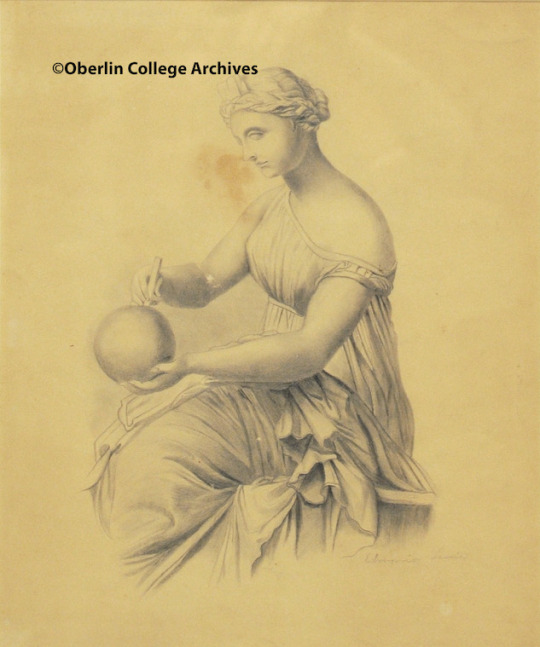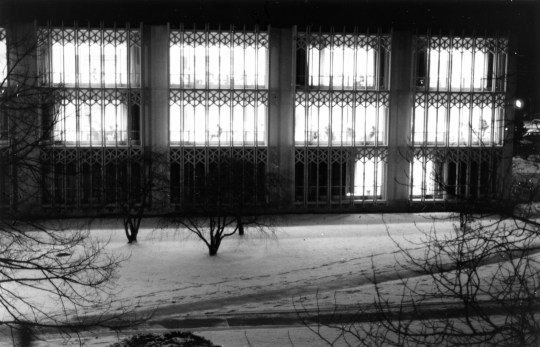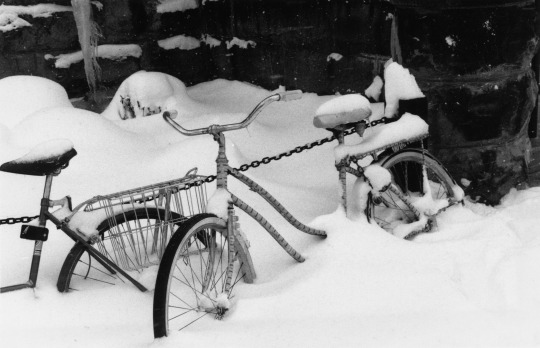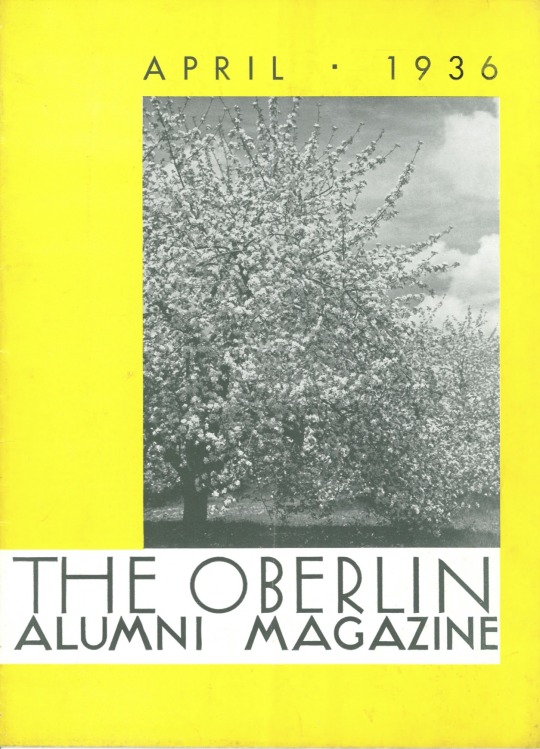Find us at: http://www.oberlin.edu/archive/ About our logo: This drawing by Herbert Fairchild Stevens, an 1890s Oberlin student, represents a composite of College buildings ca. 1897, including Peters Hall, Baldwin Cottage, and Talcott Hall....
Don't wanna be here? Send us removal request.
Photo

Important Announcement!
We will officially be moving all upcoming Oberlin College Archives posting to the Oberlin College Libraries news page. Don’t worry! This Tumblr will remain active and we will not be deleting it if you are looking for a past post.
We also have an Instagram (@oberlincollegearchives) if you are interested in following us there.
Thank you all so much for the follows and likes throughout the years!
5 notes
·
View notes
Photo

Edmonia Lewis and Oberlin College
The United States Postal Service has announced that artist and sculptor Edmonia Lewis will be featured on a Forever Stamp, the 45th stamp in their Black Heritage series. The stamps will be dedicated and go on sale on January 26, 2022.
Edmonia Lewis was born in New York or Ohio in 1843 or 1845 to a free Black father and Native American mother. Also known as Mary Edmonia Lewis, not much is known about her early life. Lewis attended the Oberlin Preparatory Department from 1859-1860, and the Literary Department (women’s course) from 1860-1862. Unfortunately, Lewis was accused of poisoning two of her white classmates with wine in 1862 (see “Spiced Wine” by Geoffrey Blodgett, Oberlin Alumni Magazine, February 1970). The case was later dropped after being represented by John Mercer Langston. Later, in February of 1863, she was accused of (later acquitted) stealing paint brushes and paints from an art teacher in Oberlin. Because of the incidents that Lewis was involved in, she was no longer allowed to continue in the women’s course and subsequently left Oberlin for Boston where she started a career as a sculptor. Lewis sculpted noted abolitionists, and is well known for using Italian style to depict Native American subjects.
The College Archives does not hold a personal paper collection for Edmonia Lewis, but we do have a pencil drawing, pictured above, located in our Paintings, Prints, and Drawings collection. This drawing was done by Lewis for Clara Steele Norton (Oberlin College A.B. 1862) upon her announcement to be married to Judson Cross (enr. 1855-1862). This drawing is sometimes referred to as A Wedding Gift or Untitled Drawing of Urania. (See “A Wedding Gift of 1862″ by Marcia Goldberg and William E. Bigglestone, Oberlin Alumni Magazine, June/July 1977).
We also have a variety of articles and other secondary sources on Edmonia Lewis. Please contact the College Archives if you would like to know more about Edmonia Lewis and her fascinating artistic legacy.
#Oberlin#Oberlin College#Oberlin College Archives#Oberlin College Libraries#Edmonia Lewis#Urania#Archives
56 notes
·
View notes
Photo




Welcome Winter!
While it’s not technically winter just yet (it will officially arrive on December 21 this year), it is icy cold and snow has finally been making an appearance on campus.
Above are some campus views from the 1980s-1990s of the snowy Oberlin campus, which will probably be here before we know it! Just be sure not to turn into a snow-person outside of Hall Auditorium like the two in the top photograph!
Want to see more snowy scenes from Oberlin? Feel free to contact us to check out more photos!
17 notes
·
View notes
Photo


Happy Birthday to James Harris Fairchild, and Happy Thanksgiving!
Oberlin College’s third president James Harris Fairchild was born 204 years ago on November 25, 1817. Fairchild attended the Oberlin Collegiate Institute (later Oberlin College), graduating from the College Department in 1838 and the Theological Department in 1841. He then went on to serve the college for 68 years as a professor, the College President, and a member of the Board of Trustees. Fairchild married Mary Fletcher Kellogg, one of the first four women to attend the regular college course starting in 1837. Fairchild was opposed to slavery, and allowed runaway slave John Price to be hidden in his house during the famous Oberlin-Wellington Rescue. Fairchild is pictured above in a photo ca. 1859.
As a Thanksgiving treat, the Oberlin College Libraries and Archives are excited to announce the Libraries’ 2022 calendar: “Treasures from the Libraries.” This calendar features treasures found throughout Oberlin’s libraries and archives, including objects and artworks. Donors who make a gift of $100 or more to the Mary Church Terrell Endowed Book Fund will receive this commemorative calendar. The Book Fund assists the library in expanding its collection and acquisition of materials related to cultural diversity, civil rights, community leadership, and social justice. Don’t delay and donate here today!
The Oberlin College Archives will be closed on Thursday November 26 and Friday November 27 to observe the Thanksgiving holiday. We hope you have a safe and relaxing break!
#Oberlin#Oberlin College#Oberlin College Archives#Oberlin College Libraries#James Harris Fairchild#Archives
2 notes
·
View notes
Photo

The Oberlin College Archives are hiring!
Are you a current or recent graduate student in library science, archival studies, or history? Just starting out in your archival career? Our Archives and Special Collections Intern position may be the perfect opportunity for you!
You must have a Masters degree or have a substantial amount of coursework towards your Masters degree to qualify for this position. You will gain invaluable experience in both archives and special collections, including digital work.
You can apply at this link. Please feel free to contact us with any further questions about the internship.
10 notes
·
View notes
Photo



This Week in Oberlin History: The Dedication of Second Congregational Church
Many people know of First Congregational Church, but did you know there was a Second Church as well?
In May of 1860, over 100 members of First Congregational Church split off to form Second Congregational Church. The Oberlin College Trustees agreed for the Church to be placed on College property on West College Street in exchange for Oberlin students being able to worship freely on Sundays.
151 years ago on October 23, 1870, Second Congregational Church was dedicated and remained in the building on West College Street until 1920, when First and Second Church combined and worshiped in Finney Chapel until renovations could be completed in the First Church building on Main Street.
The College purchased the building in 1927, removed the steeple, and used the building as the home for the Wright Zoological Laboratory until 1959. The building is no longer standing and now Bibbins Hall, part of the Conservatory of Music, stands on the corner of West College Street where Second Congregational Church once stood.
#Oberlin#Oberlin College#Oberlin College Archives#Oberlin College Libraries#Second Church#Oberlin History#Congregational Church#Archives
18 notes
·
View notes
Photo





100 Year Anniversary of Oberlin defeating the Ohio State Buckeyes
Almost exactly 100 years ago on October 8, 1921, the Oberlin College varsity football team beat the Ohio State University Buckeyes 7-6. This is the last time an Ohio football team has beaten Ohio State!
Oberlin and Ohio State had played each other plenty of times through the years, but by 1921 the OSU team was turning into a football powerhouse. They were considering the Oberlin game as practice for their bigger Western Conference match-ups.
Ohio State was leading 6-0 on October 8, 1921 at Ohio Field in Columbus. But Oberlin had winning plans for the game when William Parkhill scored a touchdown for 6 points and kicked a successful extra point giving them the 7-6, and ultimately winning, lead.
For more information about Oberlin’s historic win against Ohio State, check out this great article at the Oberlin College Athletics website. Also, this weekend (10/15-10/17, 2021) during the Oberlin College homecoming festivities, there will be an announcement celebrating the 100th anniversary of the 1921 game at the Oberlin vs. Wittenberg football game, so come check it out!
Next year during the annual “Battle for Ohio,” we know that we will be rooting for the Buckeyes to beat the Ohio football team they are up against and hope to keep Oberlin’s 1921 win alive!
#Oberlin#Oberlin College#Oberlin College Archives#Oberlin College Libraries#Ohio State University#Ohio State Buckeyes#Ohio Football#Archives
7 notes
·
View notes
Photo





Oberlin College in the Summer
Greetings from the Archives in sunny Oberlin! We are currently in the midst of the summer trimester for the 2020-2021 academic year. This is a little different than what we are used to, but this whole academic year has been pretty different!
A summer session is not uncommon for Oberlin College. In Oberlin’s early days, the main break for students was during the winter months, so students had a regular semester during the summer. There have also been many summer sessions throughout the years.
Check out the images above for some past summer sessions! Feel free to contact us with any questions.
#Oberlin#Oberlin College#Oberlin College Archives#Oberlin College Libraries#Summer#Summer School#Archives
7 notes
·
View notes
Photo

The Oberlin College Archives are hiring!
Are you thinking about pursuing archival work as a career, or do you have a passion for Oberlin and its history? If you are a currently enrolled, on campus, Oberlin student, please apply!
You can see the job description and apply here. Please feel free to contact us if you have any other questions about this position.
8 notes
·
View notes
Photo

Oberlin College’s First Arbor Day
Arbor Day was first celebrated in the United States in April, 1872 in Nebraska. Many cities and states followed suit in the years afterwards and would take a day to plant trees for citizens’ health and improvement of the quality of the environment. Nationally, Arbor Day is now celebrated on the last Friday of April.
Oberlin College first celebrated its own Arbor Day on April 29, 1898. Students had an entire day of holiday, and planted trees in the Ladies’ Grove, what is now known as the Arboretum (or lovingly “The Arb”). Coverage of the importance of improving Ladies’ Grove is written in the April 27, 1898 issue of the Oberlin Review. The next issue celebrates the students’ work on Oberlin’s Arbor Day, partly pictured above (view the whole issue here).
Due to the early preservation efforts of Ladies’ Grove and the surrounding land, and continuing preservation throughout the years, Oberlin now has a beautiful space that students and community members can enjoy hundreds of years later.


The Arboretum bridge, pictured above in 1935, and Plum Creek flowing through the Arb, undated.
#oberlin#oberlin college#oberlin college archives#oberlin college libraries#oberlin arboretum#ladies grove#arbor day#trees#archives
11 notes
·
View notes
Text



Oberlin's Early Fundraising Campaign: The Keep-Dawes Mission The founding and opening of the Oberlin Collegiate Institute in 1833 (later renamed Oberlin College) relied heavily on donations from abolitionists and supporters of Oberlin's moral beliefs. Loans given to Oberlin from Arthur and Lewis Tappan (noted abolitionists) were adding up, and by 1836 instructors' salaries were cut and food was reduced in the boarding hall. Donors in the area had already given to the Oberlin cause, and sources for money were drying up. In 1839, the Oberlin trustees commissioned a mission to England to solicit funding. Emancipation for slaves had been passed in 1834, so the trustees thought citizens in England would be sympathetic towards Oberlin's cause. Abolitionist William Dawes and Oberlin trustee and financial agent John Keep (who cast the deciding vote in 1835 to allow Black students to attend Oberlin) went to England to solicit donations and subscriptions. They ended up receiving $30,000, and saved the college from financial ruin.
Because of Dawes and Keep's hard work and the generosity of donors supporting Oberlin's cause, we are able to have the institution that we do all of these years later.
(Pictured above: An Oberlin Alumni Magazine article about "Father" John Keep and his importance to Oberlin, a donation receipt for engraving prospectuses for the "Oberlin Institution," and a subscription list written by William Dawes in 1839)
Today is All in for Oberlin, Oberlin's annual day of giving. If you would like to continue the cause of Oberlin like so many donors in the past, please donate today and go All in for Oberlin!

5 notes
·
View notes
Text




Springtime Scenes from the Oberlin Alumni Magazine
The trees and flowers are blooming and the weather is finally (somewhat) cooperating in Oberlin, so that means spring is here! I know a lot of you can't be on campus right now due to the ongoing COVID restrictions to enjoy the weather, but these springtime covers of the Oberlin Alumni Magazine can bring you right back from the comfort and safety of your own home.
Did you know archival issues (from 1904 to 1960) of the Oberlin Alumni Magazine have been digitized? You can get a taste of Oberlin from anywhere here. The magazine is an amazing source for articles about Oberlin College and community history (my favorite being the article in the February 1932 issue covering John Brown's connection with Oberlin College).
Please contact us if you are looking for an article or two from issues that haven't been digitized yet, and if you have any other questions!
#Oberlin#Oberlin College Archives#Oberlin College Libraries#Oberlin Alumni Magazine#Spring#Bikes#OCL Access Without Borders#Archives
10 notes
·
View notes
Text


Happy 147th Birthday to the Oberlin Review!
On April 1, 1874, the first Oberlin College Review (renamed the Oberlin Review in 1875) was published. It was started as a semi-monthly newspaper to keep faculty, students, and alumni informed of Oberlin College news and events. It also featured literary essays and social happenings. At first, the Review was not student-run, and it featured stories written by faculty, alumni, and guests.
The first issue included an introductory statement by C(harles) N. Jones (OC A.B. 1871), the Review's first editor-in-chief and a story about the growth and popularity of the Conservatory of Music, both pictured above. Click here to read Volume I, Number 1 online. (An entire run of the Review up to 2012 is also available online here.)

The Review has changed as the years have passed. Originally, the Review's office was located on Main Street, and it did not move to campus until around 1988. Some years a subscription was required to receive the Review. Stories celebrate moving from typewriters to IBM computers. A milestone story ran in national newspapers about the availability of the Review on the Palm Pilot and other PDAs in 2001 (pictured above).
While the Review is completely online right now due to the pandemic, we have been able to count on it for campus news, events, and opinions for 147 years. Here's to another 147 more!
#Oberlin#Oberlin College#Oberlin College Archives#Oberlin College Libraries#Oberlin Review#Newspapers#Student Newspapers#Archives
4 notes
·
View notes
Text

Women's History Month Spotlight: Mary Elizabeth Johnston
The Oberlin College Archives holds a personal papers collection for Mary Elizabeth Johnston (1890-1982, A.B. 1913, issued 1937). Johnston was dedicated to education as a teacher and librarian, and was a lifelong Oberlin College supporter.
Johnston was born in Sandusky, Ohio in 1890 and had two other siblings. Her father's death in 1900 led her mother to move to Oberlin so they could live with their grandparents. Mary and her siblings attended Oberlin schools, and Mary graduated from Oberlin High School in 1908. Choosing to go to Oberlin College was easy because she could live at home and work for tuition money. She entered Oberlin College in 1909, beginning her studies in English Literature. Unfortunately, Johnston was unable to keep up with her studies and work at the same time, so she left Oberlin in 1912.
Julia Finney Monroe (wife of Oberlin College professor and trustee James Monroe) took particular interest in Johnston, and recommended her for a job as a teacher at St. Augustine's College, a segregated school in Raleigh, North Carolina. Johnston taught there for over 25 years, returning to Oberlin every summer to work on her studies. Finally, in 1937, Johnston was able to finish her A.B. degree. She also received an M.A. degree in Library Science at Kent State University in 1952.
After teaching for years in New Jersey, Johnston moved back to Ohio to spend her retirement, staying active in many community organizations. She was also dedicated to funding education for Black students at Oberlin College, and signed her pension funds to the College, only withdrawing what she needed to live.

(Mary Elizabeth Johnston, pictured third from the right, with a group of Karamu House Golden Agers on a trip to Boston, MA)
Of particular note in Johnston's papers are the rich scrapbooks she kept covering her career and retirement years. One scrapbook covers the years she spent in the Golden Agers group of the Karamu House, the oldest Black theater in the United States. Here, Johnston and other retirees raised funds for shows, events, and upgrades to the building, as well as traveling in groups to see plays and experience different cities across the U.S. and Canada.

(The Karamu House Golden Agers dedicating a new flag pole in front of the building)

(The Karamu House sign, gift from the Karamu House Golden Agers, 1964)
To find out more about Mary Elizabeth Johnston and her collection, check out the finding guide and feel free to contact us for more information or images.
#Oberlin#Oberlin College#Oberlin College Archives#Mary Elizabeth Johnston#Karamu House#Black Education#Scrapbooks#Archives
31 notes
·
View notes
Text

Women's History Month Spotlight: Frances Walker-Slocum
The Oberlin College Archives holds the papers of Frances Walker-Slocum (1924-2018, Oberlin Conservatory Mus. B. 1945). Walker-Slocum had long ties to the Oberlin Conservatory of Music, and was an accomplished pianist and professor.
Walker-Slocum began her piano career early in life, starting lessons at only four and a half years old. When she was five, an accident caused her dress to catch fire and her right arm was severely burned. After about a year of recovery, she overcame her injuries and continued to practice the piano and relearn techniques due to the lasting effects of her burns. She gave her first full recital in 1941 (the same year she graduated from high school) in the Howard University Chapel in Washington, D.C.
Walker-Slocum enrolled at the Oberlin Conservatory of Music in 1941, as this was the only institution allowing Black people to earn an undergraduate degree in music. She graduated in 1945 with a Mus. B. in piano and organ. After graduating, she began her teaching career at a few institutions before becoming a faculty member at Tougaloo College. While teaching at Tougaloo, Frances met H. Chester Slocum (Oberlin College A.B. 1948). Laws in Mississippi did not allow interracial marriage and they were forced to move so they could get married.
Walker-Slocum received an M.A. at the Columbia Teachers' College in 1951. She continued teaching in New York City and other institutions on the east coast, and began her professional performance career in 1959, debuting at Carnegie Concert Hall.


(Recital program for Frances Walker-Slocum's debut at Carnegie Recital Hall, March 8, 1959)
Walker-Slocum continued teaching while still performing within the United States, most frequently in New York City and the surrounding areas. She toured in 1975-76 for the United States' Bicentennial, starting at Carnegie Recital Hall, performing the music of Black American composers (including her brother, George Walker OC 1941). She brought this concert to Oberlin College, Tuskegee University, the National Gallery of Art, and many other universities and institutions.


(Recital program for The Music of Black American Composers Bicentennial performed by Frances Walker-Slocum, September 14, 1975)
Walker-Slocum performed recitals often and toured Europe twice. On her German tour in 1982, she continued her popular Black American composers program, and included works by former Oberlin Conservatory faculty member Wendell Logan.



(Poster and recital program from Frances Walker-Slocum's tour of Germany, 1982)
Walker-Slocum began her teaching career at the Oberlin Conservatory of Music in 1976. She was the first Black woman to hold a tenured faculty position at Oberlin, and dealt with salary inequity issues during her entire tenure, due to both her race and gender. She retired in 1991, and continued to teach and perform long after.
To learn more about Frances Walker-Slocum, check out the finding guide for her papers here, and her project page on the Digitizing American Feminisms online exhibit.
#Oberlin#Oberlin College#Oberlin College Libraries#Oberlin College Archives#Oberlin Conservatory of Music#Frances Walker-Slocum#Black Composers#Black Musicians#Piano#Recital Programs
11 notes
·
View notes
Photo

Black History Month Spotlight: J.B. Stradford
John B. Stradford (J.B.) was born in 1861 in Versailles, Kentucky to J.C. Stradford, a former slave. J.B. attended the Oberlin Preparatory Department (much like a modern day high school or secondary school) from 1882-85 and did not graduate. He went on to attend the Indianapolis School of Law, graduating in 1899.
Soon after receiving his law degree, J.B. Stradford had multiple interests in the social growth of Black Americans and Native Americans, real estate, and the oil boom in America. This led him to Tulsa, Oklahoma. He was admitted to the Oklahoma bar after arriving around 1899.
Not long after Stradford made his way to Tulsa, O.W. Gurley began developing an area in Tulsa for Black owned businesses, naming the main avenue “Greenwood.” Greenwood would soon be known as Black Wall Street, allowing Black citizens to participate in the American dream and grow their businesses and their wealth.
Stradford’s interest in real estate led him to build an over 50 room hotel on Greenwood Ave. in Tulsa, and it was the largest Black owned and Black operated hotel at the time. Stradford also owned the Stradford Library and the Stradford Building in the Greenwood area.
Unfortunately, racial tensions were growing in the south and struck Tulsa on May 30, 1921, when a Black man was accused of assaulting a white woman. This accusation has never been proven, but was enough for a fight to break out that evening. On June 1, white mobs descended on Greenwood, burning buildings and even dropping bombs from airplanes. Stradford’s businesses and real estate were destroyed, along with most of the Greenwood area.
Stradford was arrested for inciting violence during the race riots, and his son, C.F. Stradford (Oberlin College A.B. 1912) filed a writ for his release. J.B., fearing for his life, never paid bail upon release and escaped, eventually settling in Chicago and never returning to Tulsa. He died in 1935
Thanks to the efforts of J.B. Stradford’s family, including his granddaughter Jewel (Stradford) LaFontant-MANkarious (Oberlin College A.B. 1943), a Tulsa jury found Stradford innocent of all charges for inciting a riot, and Oklahoma governor Frank Keating gave Stradford a posthumous executive pardon in 1996.

(Citation given to the Stradford family, recognizing J.B. Stradford’s achievements on the day of his executive pardon, October 18, 1996. From the Jewel LaFontant-MANkarious papers, Oberlin College Archives)
More information about the notable Stradford family can be found in the papers of Jewel LaFontant-MANkarious, held in the Oberlin College Archives. Jewel’s own career as a lawyer, United Nations Ambassador, and other United States government positions is well documented in the collection
#Oberlin#Oberlin College#Oberlin College Archives#Oberlin College Libraries#JB Stradford#Stradford Family#Black Wall Street#Tulsa#Greenwood#Archives#Oklahoma
24 notes
·
View notes
Photo

New Archives Digital Exhibition: Art in the Archives of Oberlin College
The Oberlin College Archives announces a new virtual exhibition, Art in the Archives of Oberlin College. The exhibit showcases artworks and textiles with deep stories showcasing Oberlin’s rich history: early post-secondary coeducation and the admission of Black students, antislavery, education in Asia, leadership in world affairs after World War I, an eclectic and notable built environment, and excellence in teaching and learning on campus. Art in the Archives presents selected visual works with historical context and links them to sources and related collections. Many of the works have not been presented online before, or are new acquisitions.
You can access the exhibition through the Archives website here.
(Pictured above: Gift from Monkut, King of Siam. Painting of a Southern European Landscape c.1851-68 (artist unknown) located in the Dan Beach Bradley Papers. This is one of many paintings featured in the Art in the Archives Exhibition.)
#Oberlin#Oberlin College#Oberlin College Archives#Oberlin College Libraries#Oberlin Art#Digital Exhibition#Art#Archives
4 notes
·
View notes